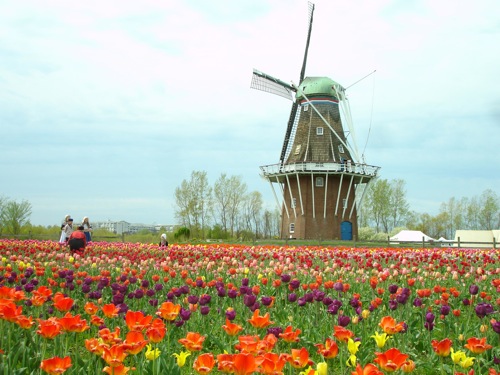
Photo by Sara Simmons, courtesy Holland Area CVB
When immigrants from the Netherlands arrived in
western Michigan in the mid-
1840s, they were consumed with
carving out a settlement from swampy and insect-infested forestland. Although mainly farmers, they taught themselves to log the abundant forests.
The town of Holland began to prosper, and local lumber provided a base that made the city a major furniture-manufacturing center by the start of the 20th century.
Those early settlers might have been pleasantly surprised if they had known that the heritage and traditions they brought with them from the Old World would be a bedrock of Holland’s 21st-century economy.
“Groups very much enjoy the Dutch attractions and traditions,” said Wendy Link, sales manager for the Holland Area Convention and Visitors Bureau. “Frankenmuth, Mackinac Island and Holland are the three most-visited places in Michigan, and we get a lot of people who are doing a triangle tour of the three. Culture is big now.”
Groups can experience the town’s rich Dutch heritage with step-on guides in authentic Dutch costumes complete with wooden shoes as they visit a 250-year-old windmill imported from the Netherlands, a wooden-shoe and Delftware factory, and a replica 19th-century Dutch village.
Holland is especially popular in the spring, when the town explodes in color with more than 6 million tulips of every shape, size and color blooming throughout the town. The town celebrates its tulips and Dutch heritage with the weeklong Tulip Time Festival.
Although the CVB promotes “Visit Holland, You don’t need a passport,” Link pointed out that not everything is about the Dutch. Groups can also shop the quaint downtown, enjoy summertime street performers, take dinner cruises on Lake Macatawa and watch spectacular sunsets over Lake Michigan.
Dutch treat
Groups can not only sample traditional Dutch food in Holland, they can also learn to make some of the delicacies.
In addition to serving a full array of Dutch specialties such as “mettwurst” (pork sausage), “saucijzebroodjes” (pigs in a blanket, or pork sausage baked in pastry dough) and “erwtensoup” (pea soup), the seasonal Hungry Dutchman Cafe at Nelis’ Dutch Village offers a hands-on cooking class that teaches participants how to make “banket,” a traditional Dutch almond pastry.
“They then tour the village or have a Dutch lunch while it is baked,” said Link.
Another great Dutch dining experience is at deBoer Bakkerij and Dutch Brothers Restaurant, a full-service European-style bakery and restaurant operated by the fourth generation of deBoer family bakers.
Festive Holland
With more than 6 million tulips blooming throughout town and a rich Dutch heritage, it is not surprising that Holland celebrates in style with a spring festival to honor its heritage.
Started more than 80 years ago, the Holland Tulip Time Festival is filled with all things Dutch, big-name entertainers and “lots and lots of tulips of all colors and varieties,” said Susan Zalnis, marketing and group sales manager for the festival.
“We have three parades during the course of the week, each one themed.”
The opening Volksparade, or people’s parade, with floats, bands and Dutch dance groups, is preceded by the traditional Dutch custom of a white-glove inspection and street scrubbing by townspeople; the Kinderparade features children in Dutch costumes; and Saturday’s final Muziekparade, the festival’s grand finale, has marching bands, floats and large parade balloons.
“There is costumed Dutch dancing throughout the week at various places in town,” said Zalnis. “There are performances going on somewhere in Holland at any given time, such as jazz and barbershop harmony.”
The free Dutch Marktplaats in the civic center features entertainment, a wide variety of Dutch food, and vendors demonstrating wooden-shoe carving and Delftware painting.
“If you are coming for only a day, you should stop there,” said Zalnis. “You get a really good sampling of all things Dutch.”
Zalnis said the festival works closely with groups and provides a range of services, including itinerary planning, group meals and grandstand seating for the parades.
“Our step-on guides are very popular,” she said. “It is a three-hour tour that takes you through the tulip lanes and through town to the areas with significant tulip plantings. We want to make sure you see those.”
The festivities continue in the winter when Holland makes Sinterklaas, the Dutch equivalent of Santa Claus, the centerpiece of the annual Dutch WinterFest.
As in the Netherlands, Sinterklaas, with his red velvet robes and tall bishop’s miter, rides into town on a white horse accompanied by mischievous helpers.
The festival also includes a parade of lights, a European-style open-air Christmas market called Kerstmarkt and a Holiday Open House on downtown’s decorated main street with carolers, roasting chestnuts and open shops, boutiques and galleries.











